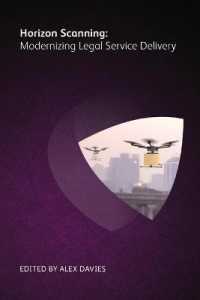Full Description
The COVID-19 pandemic has changed working practices across the globe. It has been predicted that as much as 80 percent of the legal workforce will remain transient or permanently working from home after the COVID-19 crisis ends, with only around a fifth as full-time office workers. Although law firms typically weather downturns better than the overall economy, revenues, working practices, and working culture will all change.
The expected economic downturn may not directly translate into a decline for professional services, as market difficulties, regulatory responses, stimulus programs, changes in employment, and other stressors provide potential sources of demand - particularly in the legal sector.
What is clear is that personnel issues will come to the fore, and law firm leaders will have to respond proactively, both to mitigate risk and to make the best of a challenging and changing situation.
Transitioning from an industry famed for office working to one that is more responsive, flexible and individualistic will provide as many opportunities as it will challenges.
Contents
Chapter 1: The secret to profitability and professional satisfaction
By Michael Roster, formerly managing partner of Morrison & Foerster's Los Angeles office
Chapter 2: How hiring non-legal talent is essential in the new legal ecosystem
By Jon Whittle, Lexis Nexis
Chapter 3: Professionalizing business talent
By Jennifer Johnson, CEO and founder of Calibrate Legal, and Erin Meszaros, chief business development and client service officer at Eversheds Sutherland
Chapter 4: Culture as a core and essential component of your firm's future health
By Susan Duncan, Rainmaking Oasis
Chapter 5: Prioritizing wellbeing in a time of change
By Bree Buchanan, founding co-chair of the National Task Force on Lawyer Well-Being, and Jonathan Beitner, chair of the American Bar Association's Commission on Lawyers' Assistance Programs' Well-Being Committee
Chapter 6: Mental health and wellbeing during the pandemic and beyond
By Renee Branson
Chapter 7: Gen Z in COVID 's cross-hairs - conversations to strengthen generational teams
By Lauren Stiller Rikleen, president, Rikleen Institute for Strategic Leadership
Chapter 8: Homeworking - challenges and opportunities
By Clare Harman Clark, Taylor Wessing
Chapter 9: Conversations in the new normal
By Chris Marston, chief executive, LawNet
Chapter 10: The logistical and human challenges of the pandemic - a case study
By Chris Boyd, Allison Blixt, and Jullia Carretta, Wilson Sonsini Goodrich & Rosati
Chapter 11: The changing face of partnership - defining and rewarding the highest and best use
By Tim Corcoran







